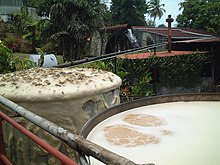Rhum agricole

Rhum agricole (French pronunciation: [ʁɔm aɡʁikɔl]) is the French term for sugarcane juice rum, a style of rum originally distilled in the French Caribbean islands from freshly squeezed sugarcane juice rather than molasses. Rhum is the term that typically distinguishes it in French-speaking locales from the rum made with molasses in other parts of the West Indies (Rum, Ron).
Overview
[edit]Cane juice rum mostly comes from Haiti, Martinique, and the Guadeloupe islands of Marie-Galante, Grande-Terre, and Basse-Terre, but is made throughout the Caribbean, including on Trinidad, Panama, the Dominican Republic and Grenada, in the Indian Ocean on Mauritius and Réunion Island, and in the Pacific Ocean on the islands of Hawaii and French Polynesia, and in Vanuatu.
Most rum is made from molasses, a byproduct of sugar refining. When France began to make sugar from sugar beets around 1811, sugar prices dropped and the debt-ridden sugar factories in the French Caribbean could not survive solely on sugar production. Fresh cane juice was now available for fermenting and distilling into rum.[1]
Martinican producers of cane-juice rums made entirely in Martinique and meeting certain production standards are entitled under French law to the appellation d'origine contrôlée (French protected designation of origin) "AOC Martinique Rhum Agricole".[2] This designation is unique to Martinique and does not define the category of cane juice rum or rhum agricole.
The French liquor company La Martiniquaise was founded by Jean Cayard in 1934 as an importer of Martinique rums and is now the second largest liquor company in France.[citation needed]
In Grande-Terre, Guadeloupe, there is Distillerie Damoiseau and in Marie-Galante there are Distillerie Bellevue, Distillerie Bielle and Distillerie Poisson (also known as Rhum du Père LaBat).

The rest of the Caribbean produces cane juice rums of varying ages. Most notable are the Barbancourt rums of Haiti which are aged to four, eight and fifteen years. There are five hundred village cottage industry producers of clairin. A form of cane juice rum first appeared in Brazil where it is called Cachaça.
With the burgeoning craft distilling scene, new world styles of rhum agricole are appearing. New world Rhum Agricole distilleries include Chalong Bay and Lamai Distilleries in Thailand and Chamarel in Mauritius. With the closure of Hawaii's crystalline sugar producing mills, some artisanal distilleries have opened which continue production of cane for rhum agricole.
Rhum agricole is also produced in Taiwan.[3]
See also
[edit]References
[edit]- ^ "History & origins". rhum-agricole.net. Archived from the original on 24 July 2011. Retrieved 24 October 2010.
- ^ "AOC Rhum Martinique description". Rhum Agricole. Archived from the original on 24 July 2011. Retrieved 18 February 2011.
- ^ Pan, Jason; Chen-hong, Hong. "Taiwanese rums win top awards in French competition". Taipei Times. Retrieved 15 March 2025.
External links
[edit]- Rhum Agricole at caribbeanspirits.com
- Rhum Agricole at cocktailatlas.com
- Descriptions of Rhum Agricole and Brazilian Cachaca
